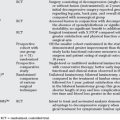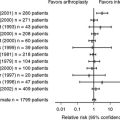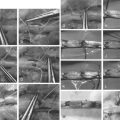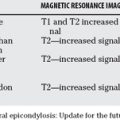Chapter 61 Subtrochanteric Femoral Fractures: Is a Nail or Plate Better?
Subtrochanteric fractures remain a problematic fracture for treatment because of the local biomechanics, deforming forces of the attached musculature, and fracture configuration. The combination of high-stress concentration in an area of dense, cortical, hypovascular bone results in a propensity for nonunion. The soft-tissue stripping from the fracture can be further exacerbated with surgical dissection, resulting in a greater risk for delayed union and nonunion.
Several classification systems are currently in use, including the Russell–Taylor classification,1 the Seinsheimer classification,2 and the AO/OTA classification. Each has its own method of stratification and nomenclature; however, they have not been shown to be useful in predicting treatment and outcome.3,4
OPTIONS
The question of whether subtrochanteric femur fractures are best treated with an intramedullary nail device or an extramedullary plate device has been long debated and studied.5,6 Devices currently in use include cephalomedullary nails, with either a piriformis or trochanteric start, and fixed-angle plating implants including blade plates, sliding hip screws, and locking plates. The purpose of this review is to guide surgeons in selecting the appropriate implant for this potentially troublesome fracture based on the best available evidence.
EVIDENCE
The available Level III and IV case series describing the treatment results with individual implants noted impressive success rates up to 100% and complication rates as low as 0%.7–11 Although these studies may give some indication as to the success and pitfalls of various implants, they provide little help in guiding treatment considerations of one implant versus another.
Specific patient or fracture characteristics may limit the treatment options available. In patients with previous surgery or hardware distally in the femur, such as a total knee prosthesis,12 with previous deformity, or in pediatric fractures with open proximal growth plates, a fixed-angle plate device may be preferred. In patients with a significant lateral soft-tissue injury, or with extensive comminution or a segmental injury extending down the femoral shaft, a cephalomedullary nail is less traumatic to the soft-tissue envelope. In the case of a pathologic fracture, a cephalomedullary nail treats the fracture and provides prophylactic support or fixation for distal lesions.13 It would be difficult to produce randomized trials for each potential scenario comparing treatment strategy, and the level of evidence in this regard is therefore limited to Level V (expert opinion).
Biomechanics
Tencer and colleagues14 compared seven devices in a cadaveric subtrochanteric fracture model tested in axial loading and found that the plate devices (compression hip screw and AO angled blade plate) failed between 1100 and 1500 N compared with a locked nail at 3000 N.
In a cadaveric study by Haynes and coworkers,15 the short Gamma nail (GN) was tested against the dynamic hip screw (DHS) in an osteotomized proximal femur simulating a subtrochanteric fracture with intertrochanteric extension. The authors found that in the harder bone model, the GN had a failure load of 5761 N versus the DHS with a failure load of 4660 N in axial loading. In the soft bone model, the failure loads were 5725 N for the GN and 3225 N for the DHS. The modes of failure were fractures of the femoral shaft around the distal locking screws for the GN, and lateral plate and screw pullout with the DHS.
Clinical Trials
Few studies include the comparison of an intramedullary device versus a plate device for subtrochanteric fractures in a randomized controlled trial. Ekstrom and coworkers16 conducted a pertrochanteric fracture fixation trial on 203 patients that included analysis of the subtrochanteric fracture data, 18 treated with the proximal femoral nail (PFN), and 13 treated with the Medoff sliding plate (MSP) (Level III). They found significant advantages in operating room time, blood loss, and earlier ability to walk 15 m at 6 weeks for those treated with the PFN. The MSP held the advantage for shorter fluoroscopy time. They also studied other functional parameters including intraoperative complications, walking ability at 4 and 12 months, hospital stay, transfusions, infection, and mortality, and they found no significant differences.
Goldhagen and colleagues17 randomized 75 patients with pertrochanteric fractures to compare the GN and the compression hip screw (CHS), which included analysis of 12 subtrochanteric fractures. The GN was used in seven patients, and the CHS was used in five. The authors found a trend for shorter operative time with the GN (82 vs. 99 minutes); however, they were unable to show statistical significance. Other outcomes studied including fluoroscopy time, blood loss, transfusions, length of hospital stay, functional outcomes, and mortality showed no difference (Level II).
In another study by Miedel and coauthors,18 217 patients with pertrochanteric fractures were randomized to treatment with the standard Gamma nail (SGN) or a MSP. Their analysis included stratification of some of the subtrochanteric fracture data: 16 patients treated with the SGN, and 12 treated with the MSP. They report a greater postoperative fixation complication rate with the MSP with loss of reduction in two patients. In their pooled data analysis of all the fractures, they report better operative reduction, less blood loss, and lower mortality for those treated with the SGN. Other outcomes examined including intraoperative fractures, operative time, transfusions, infections, length of hospital stay, and functional outcomes showed no significant differences.
Parker and Handoll19 report in the Cochrane review on cephalomedullary versus extramedullary implants for the treatment of extra-articular pertrochanteric fractures that there were better intraoperative results and less fracture fixation complications in the subtrochanteric subgroup treated with a cephalomedullary device (Level I).
Of the available randomized trials that pooled subtrochanteric and intertrochanteric data, most of the outcomes studied showed no difference, except for a significant incidence of femoral shaft fracture with the use of a short intramedullary device, and a subsequent greater reoperation rate20,21 (Level II).
Nails
The complication of femoral shaft fracture with short intramedullary devices has prompted further implant design and study. Kraemer and coworkers22 used a cadaveric model to compare the Russell–Taylor reconstruction nail, the short intramedullary hip screw (IMHS), and the long IMHS in an unstable subtrochanteric fracture. In axial loading, the reconstruction nail and short IMHS were stiffer than the long IMHS in nondestructive cyclic loading. The reconstruction nail had the highest ultimate load to failure compared with either IMHS nails and failed by femoral head screw cutout, whereas the short IMHS failed by femoral shaft fracture.
In a cadaveric study by Wheeler and colleagues,23 unstable subtrochanteric fractures were simulated and fixed with three different cephalomedullary nails, the Richards Russell–Taylor reconstruction nail, the Synthes spiral blade nail, and the Zimmer ZMS nail. The Richards and Zimmer constructs were significantly stiffer and had a higher failure load than the Synthes construct in axial loading. The Richards constructs typically failed by fracture of the distal femur at the interlocking screw holes. The Zimmer constructs failed by bending of the proximal end of the nail. The Synthes constructs failed by bending of the spiral blade and fracture of the femoral neck.
Starr and coauthors24 report on a series of pertrochanteric fractures treated with a piriformis start or trochanteric start cephalomedullary nail. They found no difference in intraoperative or postoperative parameters studied (Level I). Thus, if a nail is to be used, a long cephalomedullary nail with either a piriformis or trochanteric start and appropriate proximal and distal locking should be selected.
Plates
Tencer and colleagues14 report a study of seven types of fixation in a stable and unstable subtrochanteric fracture model. In the stable fracture model, the 150-degree hip screw and 95-degree blade plate demonstrated similar stiffness in torsion, which was significantly greater than the intramedullary implants tested (none in current use). In axial loading, both plate systems were as rigid as the nails. In the unstable fracture model, both plate systems remained stiffer than the nails in rotation, but resistance to axial loading was poor.
In a clinical trial, Madsen and researchers21 report on randomized pertrochanteric fractures that the DHS with trochanteric side plate (TSP) had less postoperative redisplacement and lag screw cutout compared with the CHS. They also report a longer hospital stay with the DHS with TSP compared with the CHS (Level I). Another study by Lunsjo and coworkers25 reports that the MSP had less fixation failure than the DHS, dynamic condylar screw, and DHS with TSP (Level I).
Nails versus Plates
With the change in practice to using long intramedullary devices, femoral shaft fracture complications are rare; however, the apparent shorter operating room time reported with short intramedullary nails compared with plates16,17 may no longer be significant because of the extra time required to lock long nails distally. The disadvantage of greater intraoperative blood loss with plating is not seen clinically after surgery with the same transfusion rates as nailing.16,18
A potential advantage of earlier return to function in unstable fractures with intramedullary nailing exists, as supported by increased resistance to axial loading seen in biomechanical studies (14, 15) and clinically by Ekstrom and coworkers,16 who reported better ability to walk 15 m at 6 weeks after surgery in those treated with an intramedullary nail. This difference is no longer seen at 4 and 12 months (Level III). This factor may be particularly important in patients who are unable to comply with postoperative weight-bearing restrictions.
Varus malreduction and inaccurate screw placement in the femoral head have been correlated with an increased risk for failure and further deformity.16 Given the lack of clear evidence of the superiority of one implant over another, it is likely more important that the surgeon chooses the implant with which they are most facile, and able to get the most accurate reduction and appropriate implant position, whereas maximally preserving the local biology and soft-tissue envelope.
With the new armamentarium of current implants and soft-tissue–preserving techniques, further study is needed to determine what differences exist between nails and plates, and in which fracture types they are best applied. Table 61-1 provides a summary of recommendations.
| RECOMMENDATION | LEVEL OF EVIDENCE/GRADE OF RECOMMEDATION |
|---|---|
1 Russell TA, Taylor JC. Subtrochanteric fractures of the femur. In: Browner BD, Jupiter JB, Levine AM, Trafton PG, editors. Skeletal Trauma. 2nd ed. Philadelphia: WB Saunders; 1992:1832-1878.
2 Seinsheimer F. Subtrochanteric fractures of the femur. J Bone Joint Surg Am. 1978;60:300-306.
3 Blundell CM, Parker MJ, Pryor GA, et al. Assessment of the AO classification of intracapsular fractures of the proximal femur. J Bone Joint Surg Br. 1998;80:679-683.
4 Parker MJ, Dutta BK, Sivaji C, Pryor GA. Subtrochanteric fractures of the femur. Injury. 1997;28:91-95.
5 Fielding JW. Subtrochanteric fractures. Clin Orthop Relat Res.; 92; 1973; 86-99.
6 Thomas WG, Villar RN. Subtrochanteric fractures: Zickel nail or nail-plate? J Bone Joint Surg Br. 1986;68:255-259.
7 Alho A, Ekeland A, Stromsoe K. Subtrochanteric femoral fractures treated with locked intramedullary nails. Experience from 31 cases. Acta Orthop Scand. 1991;62:573-576.
8 Barquet A, Francescoli L, Rienzi D, Lopez L. Intertrochanteric-subtrochanteric fractures: Treatment with the long Gamma nail. J Orthop Trauma. 2000;14:324-328.
9 Bedi A, Toan Le T. Subtrochanteric femur fractures. Orthop Clin North Am. 2004;35:473-483.
10 Celebi L, Can M, Muratli HH, et al. Indirect reduction and biological internal fixation of comminuted subtrochanteric fractures of the femur. Injury. 2006;37:740-750.
11 Pai CH. Dynamic condylar screw for subtrochanteric femur fractures with greater trochanteric extension. J Orthop Trauma. 1996;10:317-322.
12 Althausen PL, Lee MA, Finkemeier CG, et al. Operative stabilization of supracondylar femur fractures above total knee arthroplasty: A comparison of four treatment methods. J Arthroplasty. 2003;18:834-839.
13 Weikert DR, Schwartz HS. Intramedullary nailing for impending pathological subtrochanteric fractures. J Bone Joint Surg Br. 1991;73:668-670.
14 Tencer AF, Johnson KD, Johnston DW, Gill K. A biomechanical comparison of various methods of stabilization of subtrochanteric fractures of the femur. J Orthop Res. 1984;2:297-305.
15 Haynes RC, Poll RG, Miles AW, Weston RB. An experimental study of the failure modes of the Gamma Locking Nail and AO Dynamic Hip Screw under static loading: A cadaveric study. Med Eng Phys. 1997;19:446-453.
16 Ekstrom W, Karlsson-Thur C, Larsson S, et al. Functional outcome in treatment of unstable trochanteric and subtrochanteric fractures with the proximal femoral nail and the Medoff sliding plate. J Orthop Trauma. 2007;21:18-25.
17 Goldhagen PR, O’Connor DR, Schwarze D, Schwartz E. A prospective comparative study of the compression hip screw and the gamma nail. J Orthop Trauma. 1994;8:367-372.
18 Miedel R, Ponzer S, Tornkvist H, et al. The standard Gamma nail or the Medoff sliding plate for unstable trochanteric and subtrochanteric fractures. A randomised, controlled trial. J Bone Joint Surg Br. 2005;87:68-75.
19 Parker MJ, Handoll HHG. Gamma and other cephalocondylic intramedullary nails versus extramedullary implants for extracapsular hip fractures. Cochrane Database Syst Rev. 2004:CD000093.
20 Aune AK, Ekeland A, Odegaard B, et al. Gamma nail vs compression screw for trochanteric femoral fractures. 15 reoperations in a prospective, randomized study of 378 patients. Acta Orthop Scand. 1994;65:127-130.
21 Madsen JE, Naess L, Aune AK, et al. Dynamic hip screw with trochanteric stabilizing plate in the treatment of unstable proximal femoral fractures: A comparative study with the Gamma nail and compression hip screw. J Orthop Trauma. 1998;12:241-248.
22 Kraemer WJ, Hearn TC, Powell JN, Mahomed N. Fixation of segmental subtrochanteric fractures: A biomechanical study. Clin Orthop Relat Res. 1996:71-79.
23 Wheeler DL, Croy TJ, Woll TS, et al. Comparison of reconstruction nails for high subtrochanteric femur fracture fixation. Clin Orthop Relat Res. 1997:231-239.
24 Starr AJ, Hay MT, Reinert CM, et al. Cephalomedullary nails in the treatment of high-energy proximal femur fractures in young patients: A prospective, randomized comparison of trochanteric versus piriformis fossa entry portal. J Orthop Trauma. 2006;20:240-246.
25 Lunsjo K, Ceder L, Tidermark J, et al. Extramedullary fixation of 107 subtrochanteric fractures: A randomized multicenter trial of the Medoff sliding plate versus 3 other screw-plate systems. Acta Orthop Scand. 1999;70:459-466.







